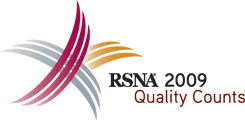
Abstract Archives of the RSNA, 2009
SSE15-01
Meniscal T1rho Obtained with 3.0T MRI Is Increased Directly after and 3 Months after Running a Marathon
Scientific Papers
Presented on November 30, 2009
Presented as part of SSE15: Musculoskeletal (Quantitative Imaging)
Christoph Stehling MD, Presenter: Nothing to Disclose
Anthony Luke MD, Abstract Co-Author: Nothing to Disclose
Robert Stahl MD, Abstract Co-Author: Nothing to Disclose
Thomas Baum, Abstract Co-Author: Nothing to Disclose
Judong Pan MD, Abstract Co-Author: Nothing to Disclose
Thomas M. Link MD, Abstract Co-Author: Research grant, Merck & Co, Inc
To prospectively evaluate changes in T1rho and T2 relaxation time in the meniscus using 3.0T MRI in asymptomatic knees of marathon runners before, 2-3 days after and 3 months after a marathon and to compare these findings to age-matched healthy subjects.
Thirteen marathon runners (mean-age 32.3 years, BMI 23.8) underwent 3.0T MRI including T1rho and T2 map sequences 2-3 days before and after competition and after 3-month. Ten physically active asymptomatic subjects (mean-age 30.5 years, BMI 23.2) not performing long-distance running were examined as controls two times in a 3-month period. Written informed consent was obtained from all subjects. Manual segmentation was performed to generate T1rho and T2 maps of the menisci in 6 different compartments (medial/lateral, anterior, posterior horn, body). Differences in T1rho and T2 values were calculated by using a paired student’s T-Test.
No differences between controls and marathoners at baseline. All marathon runners showed a significant increase of T1rho (14.7 vs. 17.3, p<0.0001) and T2 (11.1 vs. 13.6, p<0.0001) values after competition in all 6 compartments of both menisci. After 3-months T2-values decreased again (13.6 vs. 11.5, p<0.0001) in marathon runners, however, T1rho-values remained still high (17.3 vs. 17.4). In the controls no difference in T1rho (15.4 vs. 15.4) and T2 values (11.3 vs. 11.1) were determined between baseline and 3-months follow-up.
After the competition marathon runners had significantly higher water content as shown by T2 values and depletion of proteoglycans as suggested by the T1rho value increase. While T2 values decreased after 3-months T1rho values remained at a high level indicating persisting changes in the meniscal matrix composition after a marathon.
T1rho and T2 values in menisci have the potential to be used as biomarkers for diagnosing early, potentially reversible meniscus matrix changes indicating tissue damage.
Stehling, C,
Luke, A,
Stahl, R,
Baum, T,
Pan, J,
Link, T,
Meniscal T1rho Obtained with 3.0T MRI Is Increased Directly after and 3 Months after Running a Marathon. Radiological Society of North America 2009 Scientific Assembly and Annual Meeting, November 29 - December 4, 2009 ,Chicago IL.
http://archive.rsna.org/2009/8007047.html

